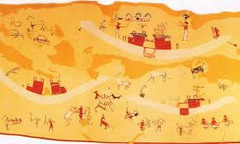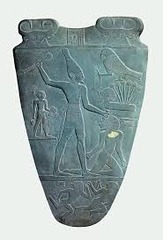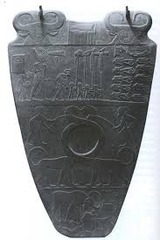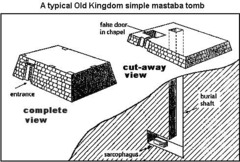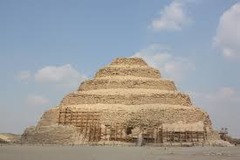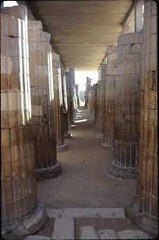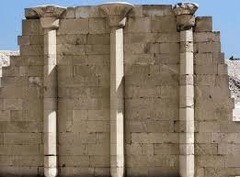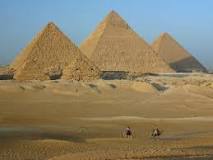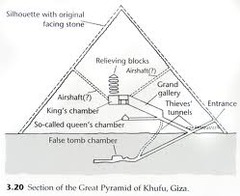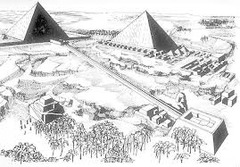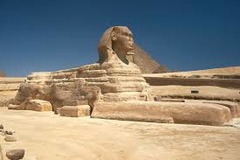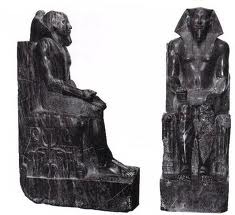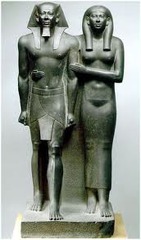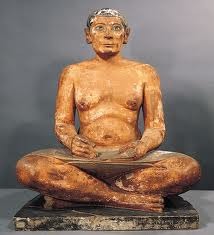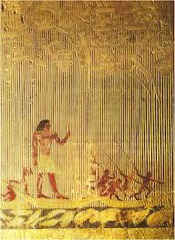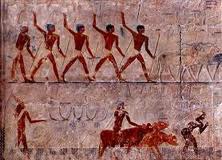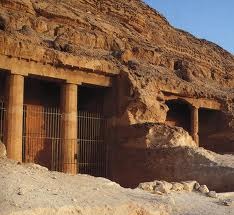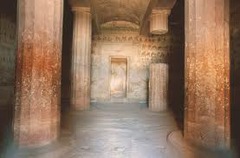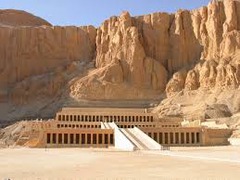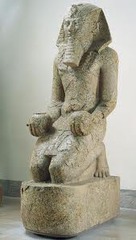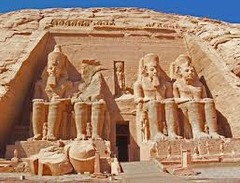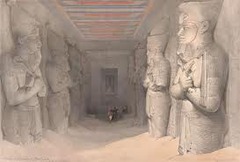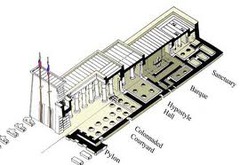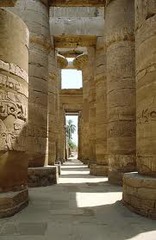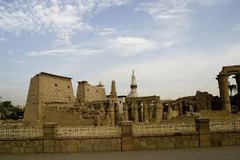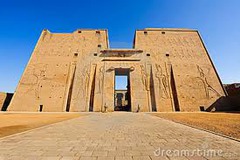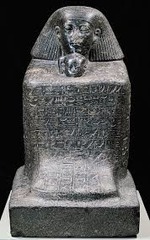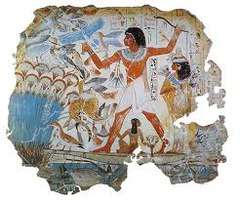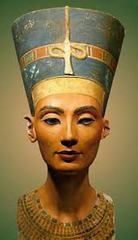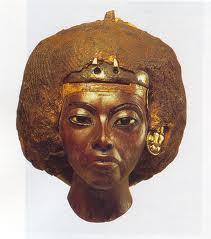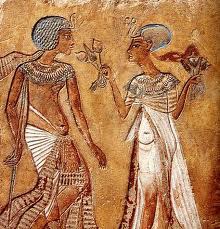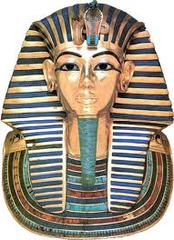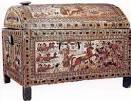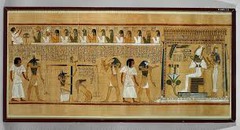*People, Boats, and Animals*
3500-3200 BC
Heirakonpolis, Egypt
Predynastic
Watercolor
Scene depicts the afterlife. Boats show people leaving life and going to the afterlife. Bottom left corner shows BTSing some people who were probably sinners. Next to them is a hook-faced man. To the right of him is a heraldic trinity.
*Palette of King Narmer (front)*
3000-2920 BC
Hierakonpolis, Egypt
Predynastic
Slate
One of the earliest historical (as opposed to prehistorical) pieces of art. Used to hold eye makeup. Top shows Hathor and the hieroglyph for Narmer. There is a falcon on a papyrus blossom, which represents Lower Egypt. The left shows a servant holding a pair of footwear. The center shows Narmer, wearing the crown of Upper Egypt BTSing a person who probabli didn't want unification. The bottom shows defeated enemies.
*Palette of King Narmer (back)*
3000-2920 BC
Hierakonpolis, Egypt
Predynastic
Slate
One of the earliest historical (as opposed to prehistorical) pieces of art. Used to hold eye makeup. Top shows Hathor and the hieroglyph for Narmer. The top register shows Narmer wearing the crown of Lower Egypt with his army. Soldiers carry standards. There are ten beheaded enemies who have their heads between their legs. The middle shows feline beasts with long necks intertwining, symbolizing unification. The hole in the middle was used to hold makeup. The bottom shows a bull destroying a rebellious city, which is seen from an aerial view.
*Egyptian Mastaba*
Most were used for single burials. The hole in the top leads down to the burial chamber. The entrance leads to a chapel and a statue of the deceased person.
*Stepped Pyramid of King Djoser*
*Imhotep*
2630-2611 BC
Saqqara, Egypt
Predynastic
stone and limestone
Composed of mastabas stacked up on top of each other. Serves to protect King Djoser's new home. Faces point in cardinal directions. Protective wall surrounding it.
*Columnar Entrance to the Mortuary Precinct of Djoser*
*Imhotep*
2630-2611 BC
Saqqara, Egypt
Predynastic
Resemble Greek columns, as they probably influenced the Greeks. Upper parts are preserved.
*Façade of the North Palace*
*Imhotep*
2630-2611 BC
Saqqara, Egypt
Predynastic
Capitals are preserved, they take the shape of papyrus blossoms while the pillars resemble papyrus stalks. Columns are engaged (attached) to the walls
*Great Pyramids*
2550-2472 BC
Gizeh, Egypt
Old Kingdom
Stone
Shape was probably molded after a ben-ben. Pharaohs were influenced by the people of Heliopolis. The oldset of the Seven Ancient Wonders of the World
*Great Pyramid of Khufu*
2550 BC
Gizeh, Egypt
Old Kingdom
Stone
Khufu's pyramid is the biggest and oldest out of the three. Grave robbers invaded the tomb. Many valuable items were placed in it with the pharaoh.
*Reconstruction Drawing of the Pyramids*
2550-2500 BC
Gizeh, Egypt
Old Kingdom
Stone
Reconstruction of what the pyramids would have looked like in their full glory.
*Great Sphinx*
2520-2494 BC
Gizeh, Egypt
Old Kingdom
Ashlar Masonry
Next to the causeway of the Pyramid of Khafre, probably to protect it. Similar role to the lions at Boghazköy and the lamassus. Various theories about why the face is a different shade than the rest of the body.
*Seated Statue of Khafre*
2520-2494 BC
Gizeh, Egypt
Old Kingdom
Diorite
The diorite was brought 700 miles so that it could be carved. These are the only organic forms in Khafre's temple, contrasting with the geometric temple. Intertwined papyrus and lotus are carved between the throne's legs, which is the symbol of unified Egypt. The falcon of Horus is behind Khafre's head, indicating his divine status. He wears the *nemes* headdress with the *uraeus* cobra in front of it. The pose is bilaterally symetrical. Finishing was done by abrasion
*Menkaure and His Queen*
2490-2472 BC
Old Kingdom
Gizeh, Egypt
Slate
Statues are wedded to their pedestal. Rigidly frontal. The couple shows no sign of emotion or affection for each other. He wears a nemes
*Seated Scribe*
2450-2350 BC
(from his mastaba) at Saqqara,Egypt
Old Kingdom
Painted Limestone
Really stiff posture, however the color makes it more life-like. Face shows the personality of the subject.
*Ka-Aper*
2450-2350 BC
(from his mastaba) at Saqqara,Egypt
Old Kingdom
Wood and Rock Crystal
Stands in conventional left-foot-forward pose. Stands more freely because it is in the round.
*Ti watching a Hippopotamus Hunt*
2450-2350 BC
(mastaba of Ti) Saqqara, Egypt
Old Kingdom
Painted Limestone
The water, signified by wavy lines, is crowded with hippos and fish which the people are hunting. Uses conceptual, not optical approach. Shows timelessness and unchanging things. Applied a strict *canon*, system of proportions, to the human figure.
*Goats Treading Seed and Cattle Fording A Canal*
2450-2350 BC
(mastaba of Ti) Saqqara, Egypt
Old Kingdom
Painted Limestone
Separated into two registers. The bottom shows people herding cattle. The top shows men in profile with raised knives following their cattle. Probably symbolic.
*Rock-cut Tombs*
1950-1900 BC
Beni Hasan, Egypt
Middle Kingdom
Replace the mastabas of the Old Kingdom. Hollowed out of the cliffs at remote sites, these tombs were often fronted by a shallow columnar vestibule, which led into a columned hall and then into a sacred chamber.
*Interior Hall of the Rock-cut Tomb of Amenemhet*
1950-1900 BC
Beni Hasan, Egypt
Middle Kingdom
The columns serve no supporting purpose because they are still engaged. Shafts are fluted.
*Mortuary Temple of Hatshesput*
Senmut
1473-1458 BC
Deir el-Bahri, Egypt
New Kingdom
Three colonnaded terraces connected by ramps. Fits into the nature, the pattern mimics the limestone above. Colonnade pillars, which are rectangular or *chamfered* (flattened at the edges) are rhythmically spaced. First tribute to a woman's achievement. On the lowest terrace, she is portrayed as a sphinx. Many statues on the uppermost level.
*Hatshesput with Offering Jars*
1473-1458 BC
Deir el-Bahri, Egypt
New Kingdom
Red granite
Kneels holding an offering jar as she takes part in honoring the sun god. Wears a nemes. She looks like a male, anatomically. Uraeus head was hacked off.
*Temple of Ramses II*
1290-1224 BC
Abu Simbel, Egypt
New Kingdom
Four colossal images of himself on the temple façade.
*Interior of the Temple of Ramses II*
1290-1224 BC
Abu Simbel, Egypt
New Kingdom
Giant figures of the king face each other in a narrow corridor. Columns have no lode-bearing purposes.
*Temple of Amen-Re*
Karnak, Egypt
15th century BC
New Kingdom
The temple rises from the earth as the Ben-Ben rose at the beginning of time. *Pylon temple*. Bilaterally symmetrical. Few people could enter the great sanctuary. The dominating feature is the facade of the pylon.
*Hypostyle Hall of the Temple of Amen-Re*
Karnak, Egypt
15th century BC
New Kingdom
Hall between the court and sanctuary. Long-axis. Has massive columns and stone slabs placed on lintels. Impost blocks. Raised the central section which created a *clerestory*. Openings let light filter in. Has sunken relief structure on it.
*Temple of Amen-Mut-Khonsu*
1390-1224 BC
Luxor, Egypt
New Kingdom
Shows typical New Kingdom columns. Derived from technique that used bound reeds as roof supports in adobe structures. These have bud cluster shapes.
*Temple of Horus*
237-47 BC
Edfu, Egypt
New Kingdom
Still follows the basic scheme architects worked out before. Great pylon at entrance. Shows Horus and Hathor witnessing King Ptolemy XIII smiting enemies.
*Senmut with Princess Nefrua*
1470-1460 BC
Thebes, Egypt
New Kingdom
Granite
Block statues, like this one were extremely popular. The idea was that the ka could find an eternal home in them. Hatshepsut's chancellor (lover?) holds the daughter of Thutmose II. Also reflects power of the former female pharaoh. Shows the relationship between Hatshepsut, her daughter, and Senmut.
*Fowling Scene*
1400-1350 BC
(from the tomb of Nebamun) Thebes, Egypt
New Kingdom
Fresco on Dry Plaster
Nebamun was a nobleman. Shown standing in his boat and flushing birds from a papyrus swamp. His back foot is lifted which shows movement. He holds three caught birds. Shows naturalism with all the animals. *Fresco seco*, letting plaster dry before painting.
*Musician and Dancers*
1400-1350 BC
(from the tomb of Nebamun) Thebes, Egypt
New Kingdom
Fresco on Dry Plaster
Nebamun was a nobleman. Almost nude girls perform at a banquet. Their profile view shows their lesser importance. Two women sit frontally, which is very rare.
*Akhenaton*
1353-1335 BC
Karnak, Egypt
New Kingdom (Amarna)
Sandstone
Retains the frontal pose of pharaoh portraits. The body does not look like the previous idealized pharaoh sculptures. His body is misshapen and looks weak. Curiously portruding hips.
*Nefertiti*
*Thutmose*
1353-1335 BC
Tell el-Amarna, Egypt
New Kingdom (Amarna)
Painted Limestone
Limestone bust of Akhenaton's queen. Left eye socket is missing the inlaid eyeball. Exaggerates the weight of the head.
*Tiye*
Gurob, Egypt
1353-1335 BC
New Kingdom (Amarna)
Wood
Cheif wife of Amenhotep III. Akhenaton's mother. GOld band, alabaster, and lapis lazuli adorn this portrait.
*Smenkhkare and Meritaten*
1353-1335 BC
Tell el-Amarna, Egypt
New Kingdom (Amarna)
Painted Limestone
Akhenaton's half-brother. Curves replace rigid straight lines. Departures from formality include the elongated necks and prominent bellies.
*Innermost Coffin of Tutankhamen*
1323 BC
Thebes, Egypt
New Kingdom
Gold with inlay of precious stones
Three coffins nested like Russian dolls. Innermost is the most luxurious.
*Death Mask of Tutankhamen*
1323 BC
Thebes, Egypt
New Kingdom
Gold with inlay of precious stones
Shows the extent of grandeur and wealth that the pharaohs possessed.
*Painted Chest from Tutankhmaen's Tomb*
1333-1323 BC
Thebes, Egypt
New Kingdom
Wood
Represents the boy king as a conqueror. Lid shows him as a successful hunter pursuing animals. In another panel he draws his bow against Asian enemies. Has curvilinear forms.
*Last Judgement of Hu-Nefer*
1290-1280 BC
Thebes, Egypt
New Kingdom
Painted papyrus scroll
Shows the final judgement of the deceased according to the *Book of the Dead*. Anubis leads Hu-Nefer to judgement. His heart is weighed against Maat. He is justified and brought to Horus.
*Mentuemet*
650 BC
Thebes, Egypt
New Kingdom (Late)
Granite
Looks really rigid and straight like an Old Kingdom work. The double wig and detailed head make it New Kingdom.
